Audio Performance
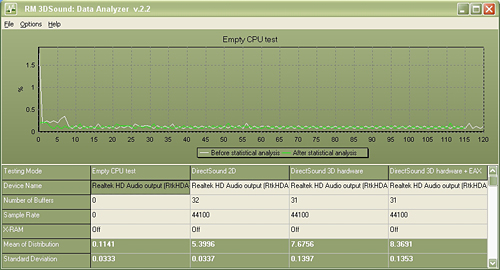
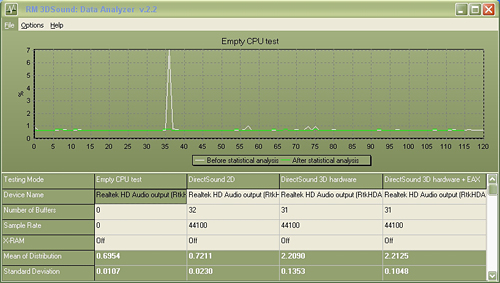
We limited audio testing to the Rightmark 3D Sound version 2.2 CPU utilization test and tested with sound enabled to show the performance effects on several games. The Rightmark 3D Sound benchmark measures the overhead or CPU utilization required by a codec or hardware audio chip.
The Realtek ALC-882D HD audio codec was tested with the recently released 1.34 driver set. The Realtek DirectSound audio drivers do not support more than 32 hardware buffers and the OpenAL 1.1 drivers do not support more than 30 hardware buffers at this time, so the scores cannot be directly compared to the Creative Labs Sound Blaster X-FI cards in the benchmarks.
We ran this benchmark with the standard test platform AMD Athlon64 4000+ CPU and also our AMD Opteron 170 dual-core CPU. It is interesting to note the reduced CPU utilization with the Opteron 170 as the load is balanced between each processor with the Realtek 1.34 drivers. We will be investigating if the reduction in CPU utilization rates with the dual-core setup has any bearing on actual game benchmarks in the near future.
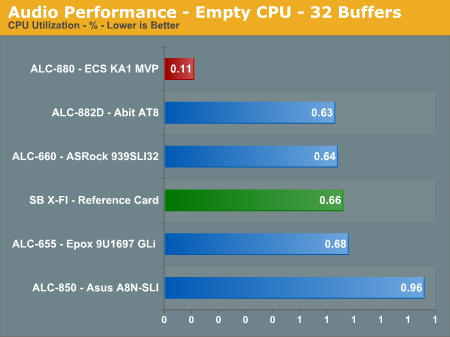
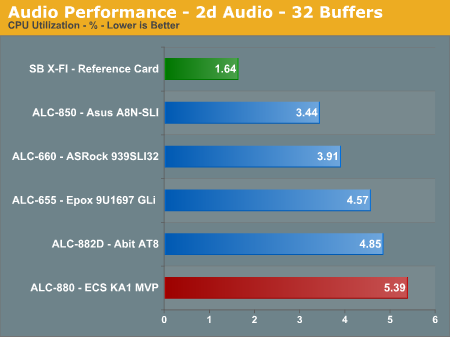
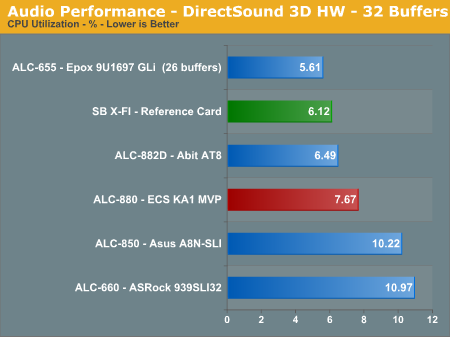
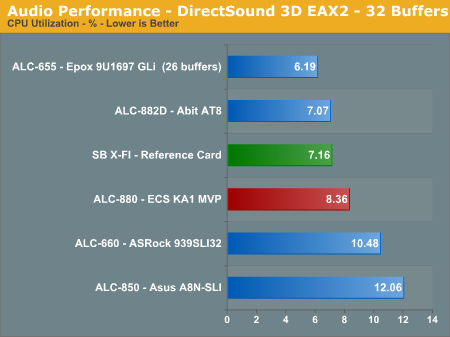
The Realtek ALC-880 codec offers competitive CPU utilization rates when compared to the Realtek ALC-882, ALC-660, and ALC-850 codecs. The ALC-880 generates significantly better audio quality than the ALC-850 based systems and very similar audio quality to the ALC-882 solutions. The ALC-880 was released before the ALC-882 but has nearly the same audio quality and performance. In our subjective headphone testing we noticed a slight difference between the two codecs, with the output from the ALC-882 sounding clearer in the treble and mid-range tones. However, the difference was negligible when utilizing our 4, 5.1, or 7.1 speaker setup in a typical room environment. The Sound Blaster X-FI has the lowest overall CPU usage with the ALC-882 and the ALC-880 following closely. Let's find out how these results translate into real world numbers.
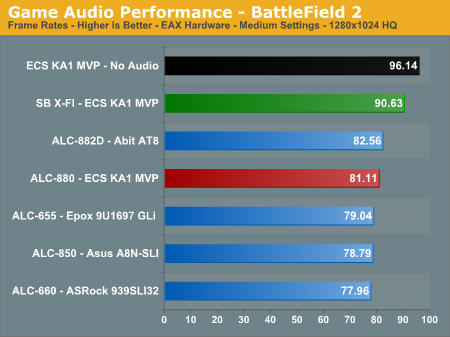
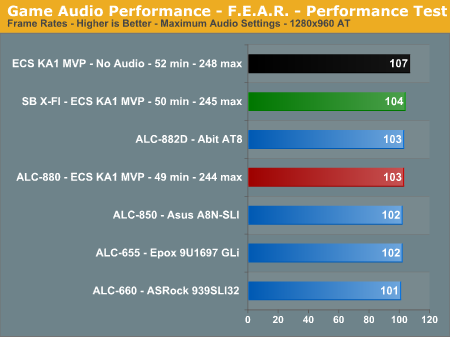
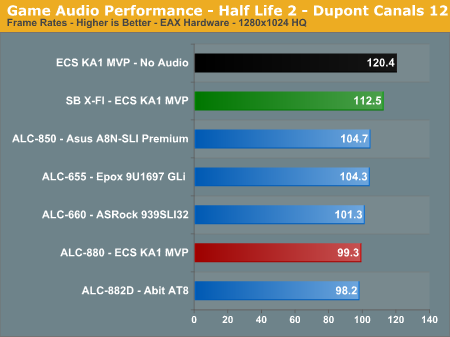
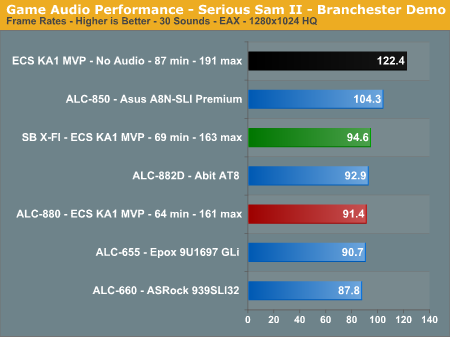
The audio performance numbers remain consistent as the Realtek ALC-880 finishes near the SoundBlaster X-FI benchmarks. Serious Sam II has an average loss of 39%, Battlefield 2 at 18%, Half Life 2 at 21%, and F.E.A.R. at 4%.
The output quality of audio with the Realtek ALC-880 ranks with the ALC-882/883 series as the best of the on-board HD audio solutions we have heard, and performance continues to improve with each driver release. The vast majority of users should have no issues utilizing the ALC-880 as their primary audio solution considering quality of audio and performance at this time in most applications.
Obviously, if you are a serious gamer, then a dedicated sound card is still useful to ensure consistent frame rate averages across a wide variety of games, and in the case of the Sound Blaster X-FI you also get improved audio quality and EAX3/4/5 support. If you'd like more details on the Realtek solution, you can refer to the ALC-880 audio specifications.
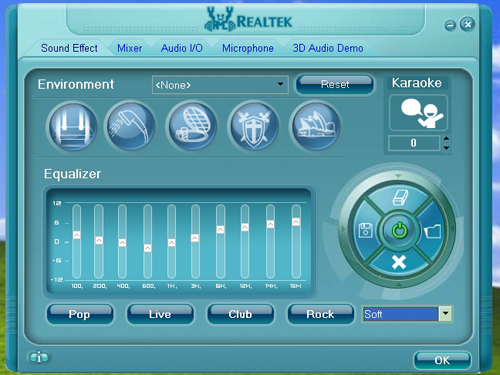
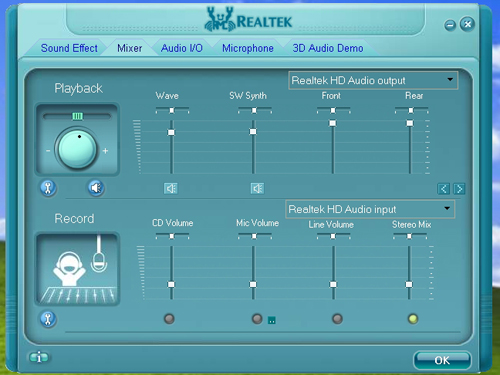
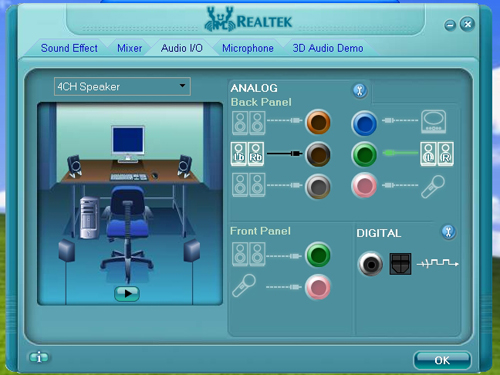
The Realtek 1.34 HD driver installation installs a basic control panel that features a built in 10-band equalizer along with the standard mixer and speaker controls. We found the control panel to be user friendly and a definite improvement over the standard windows audio properties application.


We limited audio testing to the Rightmark 3D Sound version 2.2 CPU utilization test and tested with sound enabled to show the performance effects on several games. The Rightmark 3D Sound benchmark measures the overhead or CPU utilization required by a codec or hardware audio chip.
The Realtek ALC-882D HD audio codec was tested with the recently released 1.34 driver set. The Realtek DirectSound audio drivers do not support more than 32 hardware buffers and the OpenAL 1.1 drivers do not support more than 30 hardware buffers at this time, so the scores cannot be directly compared to the Creative Labs Sound Blaster X-FI cards in the benchmarks.
We ran this benchmark with the standard test platform AMD Athlon64 4000+ CPU and also our AMD Opteron 170 dual-core CPU. It is interesting to note the reduced CPU utilization with the Opteron 170 as the load is balanced between each processor with the Realtek 1.34 drivers. We will be investigating if the reduction in CPU utilization rates with the dual-core setup has any bearing on actual game benchmarks in the near future.




The Realtek ALC-880 codec offers competitive CPU utilization rates when compared to the Realtek ALC-882, ALC-660, and ALC-850 codecs. The ALC-880 generates significantly better audio quality than the ALC-850 based systems and very similar audio quality to the ALC-882 solutions. The ALC-880 was released before the ALC-882 but has nearly the same audio quality and performance. In our subjective headphone testing we noticed a slight difference between the two codecs, with the output from the ALC-882 sounding clearer in the treble and mid-range tones. However, the difference was negligible when utilizing our 4, 5.1, or 7.1 speaker setup in a typical room environment. The Sound Blaster X-FI has the lowest overall CPU usage with the ALC-882 and the ALC-880 following closely. Let's find out how these results translate into real world numbers.




The audio performance numbers remain consistent as the Realtek ALC-880 finishes near the SoundBlaster X-FI benchmarks. Serious Sam II has an average loss of 39%, Battlefield 2 at 18%, Half Life 2 at 21%, and F.E.A.R. at 4%.
The output quality of audio with the Realtek ALC-880 ranks with the ALC-882/883 series as the best of the on-board HD audio solutions we have heard, and performance continues to improve with each driver release. The vast majority of users should have no issues utilizing the ALC-880 as their primary audio solution considering quality of audio and performance at this time in most applications.
Obviously, if you are a serious gamer, then a dedicated sound card is still useful to ensure consistent frame rate averages across a wide variety of games, and in the case of the Sound Blaster X-FI you also get improved audio quality and EAX3/4/5 support. If you'd like more details on the Realtek solution, you can refer to the ALC-880 audio specifications.



The Realtek 1.34 HD driver installation installs a basic control panel that features a built in 10-band equalizer along with the standard mixer and speaker controls. We found the control panel to be user friendly and a definite improvement over the standard windows audio properties application.










23 Comments
View All Comments
Per Hansson - Saturday, April 8, 2006 - link
Well, from your last mobo review: "Attention - Per Hansson by Gary Key on: Mar 23, 2006 12:06 AMRating: 4Our next article will have a high resolution picture of the capacitors and other items of importance in a pop-up window. I am sure the capacitors utilized on this board will be of interest to you. ;->"
Gary Key - Saturday, April 8, 2006 - link
Please email me - I have the photographs. We are doing some revisions on the engine and could not get these in but I did take the photographs for you.
Stas - Wednesday, April 5, 2006 - link
I always had nVidia and ViA chjpset based mobos. Now I really want an ATi based mobo. Very nice perfromance and overclockablility. It's good that ECS made a board like that, better for the competition. I got tired of seeing 1337 ASUS and DFI mobos, now it's time for less popular companies.SilverTrine - Tuesday, April 4, 2006 - link
And somehow Nvidia gets a pass for all their issues. The original Nforce was a totally unstable board on par with something like Abits awful KG7. Yet the fanboism let many to the slaughter with that board. Nforce 2 also had severe USB and IDE problems, yet fanboism kept most of that in the dark.Hopefully we can all get past the fanboism and be honest about things, as long as people are getting paid to post on boards that is a pipe dream though. We simply have to call these vultures on their conduct.
QueBert - Tuesday, April 4, 2006 - link
I owned a number of Nf2 MB's, and now a Nf3. SW-IDE doesn't work at all on any of them for me. Infact on 1, it actually caused my burner to not burn until I uninstalled them. Nf3 I have the lovely NF Firewall thing, does this work even somewhat for anyone? I'm not a fan boy, but from my past Nvidia experince (and remember I run a NF3 board now...) the ATI couldn't possibly be much worse. could this board be bad? sure, you can take a decent chipset and ruin it with a poorly designed motherboard.bob661 - Tuesday, April 4, 2006 - link
I'm going to test the firewall sometime when I get the chance. I'm willing to bet I won't have problems but I could be wrong.Regs - Tuesday, April 4, 2006 - link
Examples of the peripherals that are suffering? Any one else want to fill me in?
Gary Key - Tuesday, April 4, 2006 - link
The Firewire and Marvel Gigabit Ethernet controller are tied to the SB450. The performance of these items are sub-par compared to results on other boards. This is explained in the test detail sections and the final words recap. We have a new bios today that should bring the performance of both peripherals up to par with other boards that utilize this same components. However, there is nothing that can be done with the USB 2.0 performance although it really is not that bad. :)JakeBlade - Tuesday, April 4, 2006 - link
I find it amazing that this website can test a motherboard more thoroughly than the company who makes it. Pathetic.highlnder69 - Tuesday, April 4, 2006 - link
You might want to fix the word mothergoard in the title to be motherboard..